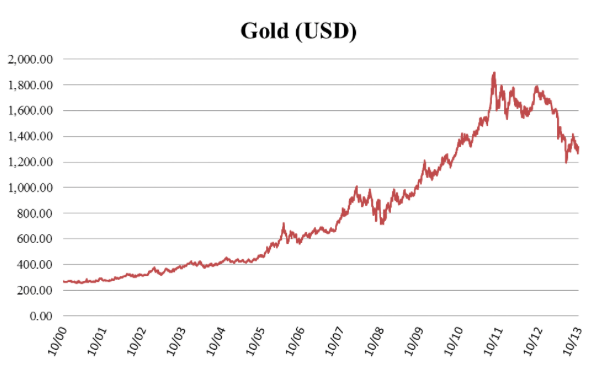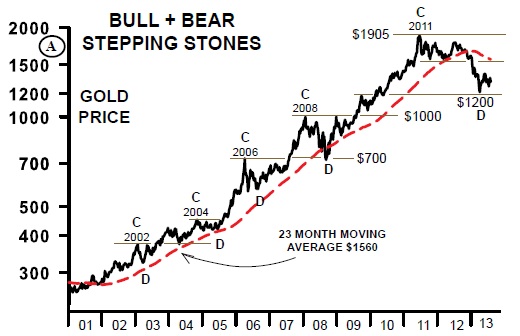Gold & Precious Metals
WHAT TURBULENT TIMES MEAN FOR GOLD
Posted by Larry Edelson: Swing Trading
on Monday, 2 December 2013 16:58
I hope you had a wonderful Thanksgiving weekend with family and friends. I did!
But now, it’s back to work. It’s back to protecting and growing your wealth. As we come closer to 2014, that’s more important than ever.
The chief reason — and I’ll keep harping on this until I’m blue in the face — is the ramping up of the war cycles.
They are going to wreak havoc starting in 2014. They are going to increase in intensity each and every year for the next six years. They are going to alter everything you thought you knew about the economy, about the markets, about politicians … and more.
And if you are not careful and open-minded, they are going to destroy your wealth.
Let’s get something straight. I am not a pessimist. I am not an “end of the world” analyst. I am simply a historian, steeped in how governments and markets are cyclical in nature, and how those who don’t learn from history are doomed to repeat the mistakes of the past.
The war cycles are real. They are documented and scientifically proven and based on over 14,000 wars spanning 5,000 years of civilization. I have studied them in great detail. They are ramping up big time and they will have a profound impact on everything.
What is behind the war cycles? What drives society and the world to enter turbulent times?
There are two forces: The private economy and the public sector (government).
In the best of times, when the interests of the private and public sectors are aligned, you get as close a partnership as you can.
There’s good economic growth. There’s cooperation. There’s rising employment, little or no inflation, increased productivity.
But in the worst of times, when the underlying economy goes into a bust period, as it has been doing since the year 2000 — you get a divide between the public and the private sectors.
It may seem that their interests are still aligned. After all, both the government and the private sector want the economy to get back on track, employment to rise again and everything to be A-OK.
 But in bad economic times, the self-interest of government rises to the top. Seeing diminished revenues and unable to curtail spending, governments start to go broke. As they go broke, they turn against their citizens and seek more ways to soak money from them while at the same time cutting and even reneging on promises.
But in bad economic times, the self-interest of government rises to the top. Seeing diminished revenues and unable to curtail spending, governments start to go broke. As they go broke, they turn against their citizens and seek more ways to soak money from them while at the same time cutting and even reneging on promises.
Meanwhile, central banks try to paper over the mess, printing money with reckless abandon.
As the tensions mount between the public and private sectors, protests erupt. There are tax revolts. Riots in the streets. Secession movements. Civil strife.
Between nations, governments battle their own self-interests, with currency wars, protectionism, trade barriers, capital controls and more.
Natural-resource wars intensify. Religious battles intensify. And if leaders don’t act appropriately — which they almost never do — all hell can break loose, leading to domestic and international conflict.
Front and center is none other than your wealth. The purchasing power of your money. The life of hard work you devoted to your family and its financial security. Your liberties. Your privacy.
For in the end, bankrupt governments want to grab your money to make themselves whole.
They engage in propaganda and desperate socialist moves to spread the wealth in some utopian vision of the world that is really nothing more than grabbing everyone’s wealth to feed a monster that is going belly up.
Think of the British and the American revolution. The original Tea Party and “no taxation without representation.” Think of the French Revolution. The fall of Rome and Byzantium.
In each and every one of those instances, and countless others, government crossed the line and invaded the private sector first, confiscating wealth to pay for its mistakes to desperately try and survive.
In times like those — the times we are now entering — the single best thing you can do is to think independently.
Question everything governments say and do. They will be acting entirely out of self-interest. They will deceive you, lie to you, all the while they are reaching into your back pocket to grab what they think is theirs.
Fortunately, today we have a slew of liquid markets where you can protect yourself and even grow your money. But, again, it all depends on your ability to think for yourself.
Case in point: Germany. Remember last January when Germany announced it was repatriating its gold from the New York Fed to take it back to Germany?
Back then, almost every analyst and gold investor on the planet said that was the most bullish news for gold they had heard in a while. That it would set gold on a trajectory to much higher prices.
Not me. I told everyone I could that it was a bearish sign. I told everyone Germany was taking its gold home to do an audit and to prepare to become a gold seller.
And I was right. Twice this year, Germany’s central bank dumped gold. Why? Because it needs the cash to help bail out the weaker European countries that are going bankrupt.
Another case in point: Obamacare. A noble effort to provide health care to every American.
But as we now know, it’s nothing more than another tax on your wealth. A tax that is coupled with 16,000 new IRS agents hired to monitor Obamacare. But, in reality, agents who will be able to eavesdrop and stick their nose into everything you do.
NSA spying on all Americans? How many times have you heard that it’s designed to protect you? Nothing could be further from the truth. A government that protects its citizens never eavesdrops on them, except those it suspects have terrorist ties.
Or look at Angela Merkel’s recent move ? outlawing all referendums in Germany under the guise of a better, more productive government, when in reality, it’s nothing more than a dictatorial power grab.
Or Sen. Harry Reid’s action last week to strike down nearly 225 years of filibuster precedent, handing Obama a similar power grab.
Nothing is ever as it seems in the halls of government. That’s true even in the best of times.
In the weeks, months and years ahead — reading between the lines of what governments are doing and saying on both sides of the Atlantic will be far more important than deciphering economic statistics or central bank monetary policy.
Keep your eye on gold. It is now heading into a January low. Once it bottoms, take that as your sign that the war cycles will be ramping up big time.
Best wishes, and stay safe and well,
Larry
Also on SwingTrader:
Too Much Oil: U.S. Storage Set to Pass the 400 Million Threshold
Triple-Digit Gains Are on Tap for This Investment, History Shows
Why it’s Okay to still be Bullish Gold: The Difference between Short & Long Term
Posted by Robert Levy - Border Gold Corp.
on Saturday, 30 November 2013 11:00
 Given the fact that the asset class of precious metals, and more generally commodities became the easiest pick for investors over the latest decade, we really shouldn’t be that perplexed with the idea of how quickly it has now been shunned by the masses. As the price of gold continues in a downtrend, the widely popular SPDR Gold Trust ETF is seeing its lowest levels since 2009. But since the final surge in the price of gold was driven by a herd mentality amongst investors to protect against a stimulus program so complex it was difficult to comprehend, it’s reasonable an asset class associated with fear and uncertainty became a safe harbour of capital. More recently though, what believers of gold and other precious metals learned is the price can go down as quickly as we saw it go up, and that’s not to acknowledge that gold was in a bubble, or by some analysts’ definition has entered a bear market, but perhaps instead, a short period of consolidation.
Given the fact that the asset class of precious metals, and more generally commodities became the easiest pick for investors over the latest decade, we really shouldn’t be that perplexed with the idea of how quickly it has now been shunned by the masses. As the price of gold continues in a downtrend, the widely popular SPDR Gold Trust ETF is seeing its lowest levels since 2009. But since the final surge in the price of gold was driven by a herd mentality amongst investors to protect against a stimulus program so complex it was difficult to comprehend, it’s reasonable an asset class associated with fear and uncertainty became a safe harbour of capital. More recently though, what believers of gold and other precious metals learned is the price can go down as quickly as we saw it go up, and that’s not to acknowledge that gold was in a bubble, or by some analysts’ definition has entered a bear market, but perhaps instead, a short period of consolidation.

It’s not just because of my bias from being in the industry that I believe this Bull Run in gold is far from over. If the chart above illustrates anything, it’s that this market over the last ten years still looks rather healthy. Instead, there are some very distinct reasons why for the long term we can still be bullish on gold despite the noise we see here in the short term, and they are as follows:
- – Outlook is for record low federal funds rate (interest rates) into 2016
- – Taper of Quantitative Easing does not equate to tighter policy
- – Global recovery still remains fragile as the fiscal health governments is no better off than before the crises
The outlook for interest rates along with the fact that any upward manoeuvre in policy rates still remains the upmost threat to economic growth is what has fuelled demand for real assets over the last few years. Furthermore, record low rates have fuelled a consumption binge in the world’s developed economies that now sees the general population saddled with record debt levels. And it’s simple; in order to reign in household imbalances individuals must either save more and consume less, or grow their incomes at a faster rate than their debt. The premise now that we live in a global economy with sub-par 2 percent economic growth is what will constrain individuals and force policy makers to keep rates low for the foreseeable future.
And it’s the Federal Reserve and other central banks that offer the guidance of low rates that will continue to stimulate the economy. We are beginning to learn, and soon accept that the unconventional methods of quantitative easing have run their course. And given the improvement in the US labour market is far less than the US central banks hopes for at this point in the recovery, it’s even more evident this pending policy shift speaks more to the efficacy of its efforts than its arguably somewhat satisfactory achievements.
But finally, and this is the one point surrounding gold that almost everyone seems to have forgotten as of late, and that is the debt burdens of government that seemed to be of paramount focus during and before the great recession are no longer relevant. Paradoxically, they are actually worse than when we entered this crisis five years ago. Despite the efforts of massive stimulus programs from just about every western power, the worlds developed economies actually haven’t returned to full strength, and are even more burdened as a result of the stimulus.
And that quite simply is what kick-started gold’s run back in the beginning of this century. It wasn’t quantitative easing. And for over two years between July of 2004 and November of 2006 interest rates actually went up. But a mix of the aforementioned factors paired with the ineffectiveness of government that opts to devalue their currency in order to attempt to stimulate growth is what will eventually turn around this downturn in gold, and fortunately for some investors has created the buying opportunity of the decade.
Super Force Precious Metals Video Analysis
posted Nov 29, 2013
“Our main format is now video analysis…”
Here are today’s videos:
Gold Continuation Pattern Update Charts
GDX Volume Threshold Volume Update Charts
Silver Patience Is Sterling Update Charts
Thanks,
Morris
The SuperForce Proprietary SURGE index SIGNALS:
25 Surge Index Buy or 25 Surge Index Sell: Solid Power.
50 Surge Index Buy or 50 Surge Index Sell: Stronger Power.
75 Surge Index Buy or 75 Surge Index Sell: Maximum Power.
100 Surge Index Buy or 100 Surge Index Sell: “Over The Top” Power.
Stay alert for our surge signals, sent by email to subscribers, for both the daily charts on Super Force Signals at www.superforcesignals.com and for the 60 minute charts atwww.superforce60.com
About Super Force Signals:
Our Surge Index Signals are created thru our proprietary blend of the highest quality technical analysis and many years of successful business building. We are two business owners with excellent synergy. We understand risk and reward. Our subscribers are generally successfully business owners, people like yourself with speculative funds, looking for serious management of your risk and reward in the market.
Frank Johnson: Executive Editor, Macro Risk Manager.
Morris Hubbartt: Chief Market Analyst, Trading Risk Specialist.
website: www.superforcesignals.com
email: trading@superforcesignals.com
email: trading@superforce60.com
SFS Web Services
1170 Bay Street, Suite #143
Toronto, Ontario, M5S 2B4
Canada
###
Nov 29, 2013
Morris Hubbartt
Morris Hubbartt
trading@superforcesignals.com
trading@superforce60.com
At A Crossroads
Posted by Mary Anne & Pamela Aden- The Aden Forecast
on Thursday, 28 November 2013 14:27
Despite its recent weakness, the world is still viewing gold as a store of value.
Overall demand remains strong. As Eric Sprott points out, “It’s staggering to think demand for gold is twice global mine production.”
China is now the largest gold buyer and producer in the world. And with their economy looking better, gold continues getting a big boost from this area.
Gold’s steps are your friend
For now, all is still good on the basing front. And our best bet is to keep track of the stepping stones because gold is at a crossroads.
They served us well on the way up, and they’ll serve us well now.
Chart 1 shows gold’s steps, along with its mega 23 month moving average.

Briefly, during the up moves, the C peaks generally marked the support for the future D declines.
This was a bull market check point.
The interesting point today is that the low in June near $1200 is still higher than the prior C peak in 2008.
This is technically a good sign and if $1200 holds, it’ll be a bullish signal.
The C rise up to the 2011 peak was an unusually long C rise, but the D decline has also been unusually long. This means, on the downside, if the June low is clearly broken for a few days, we could then see the $1000 level tested, the 2008 prior C peak.
If so, the entire post financial crisis rise would’ve been erased. This would probably be the worst case scenario.
What’s best to buy & keep
Many have asked if CEF and GTU are safer and better to hold than the gold and silver ETFs, like GLD and SLV.
Both CEF and GTU are Canadian gold and silver funds that are backed up by gold and silver in their funds.
This is not necessarily the case with the ETFs. Many rumors are flying that the Comex gold warehouse supplies are way down, and during the mad ETF selling last April-May-June, China was picking up a lot of that same gold and silver.
For reasons of safety, you know gold and silver are stored with CEF and GTU, but you’ll never really know about the ETFs.
In today’s world, safety is important, and keeping the physical metals in your possession is always best, followed by CEF and GTU.
Follow the bankers
When price manipulators take the gold price down, central banks see value and buy.
Mario Draghi, the head of the European Central Bank (ECB) said it well when he explained, “I never thought it wise to sell gold because for central banks this is a reserve of safety.”
He also said it gives non-U.S. dollar countries a good protection against fluctuations of the dollar.
This is clearly a different view than Ben Bernanke’s view that nobody really understands gold prices. He doesn’t seem to enjoy talking about the barbarous relic, but stay tuned.
—
Mary Anne & Pamela Aden are well known analysts and editors of The Aden Forecast, a market newsletter named 2010 Letter of the Year by MarketWatch, which provides specific forecasts and recommendations on gold, stocks, interest rates and the other major markets. For more information, go to www.adenforecast.com
There’s an old saying to buy them when there’s blood in the streets. When it comes to mining and exploration stocks, bodies of former speculators (including yours truly) are “walking dead”
While I still believe there will need to be a significant period of base-building, some junior resource stocks seem to be priced at levels where you just can’t expect to get any more blood out of them.
One that fits that bill is Teranga Gold (TGZ-TSX-V $.50) This article did a good job of why it’s now a compelling speculation for high-risk, high-reward speculators http://seekingalpha.com/article/1863411-3-more-low-cost-small-cap-gold-producers-that-will-survive-now-and-thrive-later?source=cc
Please note – Peter Grandich owns 900,000 shares of TGZ
Peter Grandich
Athletes & Business Alliance www.scoreforbusiness.com
Trinity Financial, Sports & Entertainment Management Co. www.trinityfsem.com
This message, and any attachments to it, may contain information that is privileged, confidential, and exempt from disclosure under applicable law. If the reader of this message is not the intended recipient, you are notified that any use, dissemination, distribution, copying, or communication of this message is strictly prohibited. If you have received this message in error, please notify the sender immediately by return e-mail and delete the message and any attachments. Thank you.
-
I know Mike is a very solid investor and respect his opinions very much. So if he says pay attention to this or that - I will.
~ Dale G.
-
I've started managing my own investments so view Michael's site as a one-stop shop from which to get information and perspectives.
~ Dave E.
-
Michael offers easy reading, honest, common sense information that anyone can use in a practical manner.
~ der_al.
-
A sane voice in a scrambled investment world.
~ Ed R.
Inside Edge Pro Contributors

Greg Weldon

Josef Schachter

Tyler Bollhorn

Ryan Irvine

Paul Beattie

Martin Straith

Patrick Ceresna

Mark Leibovit

James Thorne

Victor Adair




